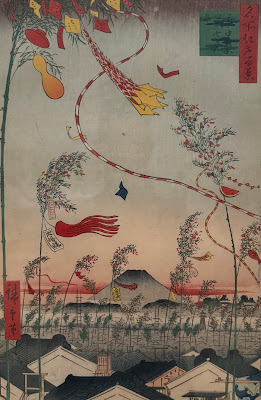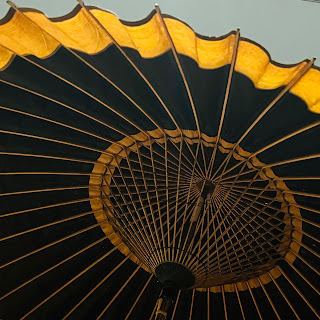Add shutterbug to the list of Paul McCartney's many creative pursuits. "Eye of the Storm 1963-64" at the Brooklyn Museum exhibits many of the mostly black & white photos he took at the height of Beatlemania.
When the "Ed Sullivan Show" beckoned in New York City, Paul, just 21, found the time to sightsee in Manhattan.
It isn't entirely clear how he managed to get in more than a few of the shots on display.
I love this picture, taken at Idlewild Airport in 1964. The fans screamed so loudly that at least one of the baggage handlers (seated @ bottom center) plugged his ears. As I looked around the gallery at the Brooklyn Museum I realized that some of the women were old enough to have been screaming their heads off. The photo has added resonance because my mother and I had flown into Idlewild a year or two earlier, en route to France. My aunt and uncle picked us up in their white Thunderbird convertible. I have no idea how we all fit.
A week after their whirlwind tour of New York, the Beatles played a second "Ed Sullivan" gig live from Miami Beach and vacationed at the recently demolished Deauville Hotel. For the exhibit, Paul created and scored a wonderful slideshow that includes plenty of camaraderie captured on Kodachrome.
By the time Paul took this photo, John's shotgun marriage to Cynthia Powell, an artist, was no longer a secret. They must have left Julian back in England. John stayed with Cynthia, who died in 2015, until he met Yoko.
From the icky expression on his face, it's clear this Beatle didn't enjoy angling.
Paul aimed his Pentax at other people, too, including Brian Epstein who managed the Beatles until his death from an accidental overdose not long after they released Sgt. Pepper's Lonely Hearts Club Band. Apparently, the world's most famous band didn't give a shit about his homosexuality; he and John had a particularly close relationship. Epstein also styled their signature mop top look.
I once found myself on a delayed flight from Montreal to New York City with the French Elvis (left). When it came time to board the plane, Johnny Hallyday lined up just like everyone else.
I wasn't aware that Tokyo used to be called Edo. The name changed a few years after the city was freshly mapped (partial view) in 1859.
Hiroshige died in 1858 during the serialization. His apprentice (and son-in-law) took over production, but the prints remain the last gasp of ukiyo-e, a Japanese genre of art that hugely influenced the European Impressionists.
 |
| "Horikiri Iris Garden" |
 |
| "Ayase River and Kanegafuchi" |
 |
| "Meguro Drum Bridge and Sunset Hill" |
The museum supplemented the exhibit with items from its extensive collection of Asian Art.
 |
| "View of Nihonbashi Töri 1-chome" |
 |
| "Towboats along the Yotsugi-döri Canal" |
 |
| "Armor-Hanging Pine, Hakkeizaka" |
 |
| "Minowa, Kanasugi, Mikawashima" |
The exhibit also includes enlarged reproductions of the views by Takashi Murakami. Bigger isn't always better; in fact, they look a little garish. I much rather would have seen the copies Van Gogh made of Hiroshige.
 |
| "Suido Bridge and Surugadal" |
 |
| Hiroshige's 100 Famous Views of Edo: Japonisme Reconsidered (2024) |













No comments:
Post a Comment